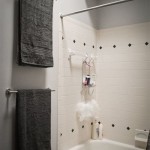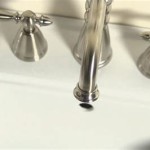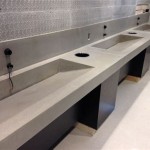What is Black Gunk in Bathroom Sink Drain?
The appearance of black gunk in a bathroom sink drain is a common household problem, often causing concern and prompting homeowners to seek solutions. This unsightly substance, frequently found clinging to the drain stopper, the sides of the drainpipe, or even protruding back up into the sink basin, is not typically a sign of a major plumbing catastrophe. However, understanding its composition and taking appropriate measures to address it are essential for maintaining a clean and hygienic bathroom environment and preventing potential drainage issues.
The black gunk is generally a complex mixture of organic and inorganic materials that accumulate over time within the drain system. Its formation is facilitated by the consistently moist and dark environment characteristic of drains, which provides ideal conditions for microbial growth and the gradual buildup of debris. Identifying the primary components of this gunk is the first step toward effectively eliminating it and preventing its recurrence.
Key Components of Black Gunk in Bathroom Sink Drains
The composition of the black gunk can vary depending on individual habits and water quality, but some common constituents are almost always present. Understanding these components is critical for choosing the appropriate cleaning methods and preventative measures.
1. Hair and Skin Cells: Human hair is a prominent component of drain clogs and black gunk. Even short hairs can accumulate rapidly, especially in shared bathrooms. Hair tends to bind with other substances, creating a matrix that traps additional debris. Similarly, dead skin cells, which are constantly being shed from the body, also collect in the drain. These organic materials provide a food source for bacteria and fungi, contributing to the growth of the black gunk.
2. Soap Scum: Soap scum comprises a mixture of soap residue, minerals in hard water (such as calcium and magnesium), and body oils. When soap interacts with hard water, it forms an insoluble precipitate that sticks to surfaces, including the interior of drainpipes. This scum acts as a binding agent, further attracting other materials and contributing to the bulk of the black gunk. Different types of soap (e.g., bar soap versus liquid soap) can contribute differently to soap scum formation, with bar soaps generally containing more tallow or fatty acids that react with hard water minerals.
3. Biofilm: Biofilm refers to a complex community of microorganisms, primarily bacteria and fungi, that adhere to surfaces within a moist environment. In bathroom sink drains, biofilm forms as these microorganisms colonize the interior of the pipes, utilizing the organic materials present (hair, skin cells, soap scum) as a food source. The biofilm itself can be black or dark in color depending on the species of microorganisms present. Furthermore, the biofilm encourages the growth of other organisms and traps more debris, accelerating the accumulation of black gunk.
4. Mineral Deposits: Depending on the mineral content of the water supply, mineral deposits can contribute significantly to the black gunk. Minerals like calcium carbonate and magnesium carbonate precipitate out of hard water and adhere to the drainpipe walls, creating a rough surface that encourages the accumulation of other debris. Over time, these mineral deposits can become incorporated into the black gunk, adding to its volume and making it more difficult to remove. Iron and manganese can also cause dark staining and deposits, contributing to the black color.
Factors Contributing to Black Gunk Accumulation
Several factors influence the rate at which black gunk accumulates in bathroom sink drains. By understanding these factors, homeowners can take steps to mitigate the problem and prevent future buildup.
1. Frequency of Sink Use: The more frequently a bathroom sink is used, the more likely black gunk is to accumulate. High usage leads to a greater influx of hair, skin cells, soap scum, and other debris into the drain, providing more material for the formation of the gunk. Bathrooms used by multiple individuals, particularly in families, tend to experience faster accumulation rates.
2. Type of Plumbing: The material and design of the plumbing system can also affect gunk accumulation. Older pipes, especially those made of cast iron, tend to have rougher interior surfaces compared to newer PVC pipes. This roughness provides more surface area for debris to cling to, accelerating the buildup of black gunk. Additionally, pipe bends and traps (like the P-trap) can create areas where debris is more likely to settle.
3. Water Hardness: As mentioned earlier, the hardness of the water supply plays a significant role in soap scum formation. Hard water, characterized by high levels of calcium and magnesium, reacts with soap to create insoluble precipitates that contribute to the black gunk. Homes with hard water supplies are more prone to soap scum buildup in their drains.
4. Insufficient Flushing: Failing to adequately flush the drain after using the sink can exacerbate gunk accumulation. Simply running the water for a few seconds after washing hands or brushing teeth may not be sufficient to effectively clear debris from the drainpipe. A longer, more forceful flush helps to dislodge and remove loose material, preventing it from accumulating over time.
5. Poor Ventilation: While not directly related to material accumulation, poor ventilation in the bathroom can contribute to a more humid environment, fostering the growth of bacteria and fungi within the drain. Adequate ventilation helps to keep the drain environment drier and less conducive to microbial growth.
Methods for Removing Black Gunk
Several methods can be employed to remove black gunk from bathroom sink drains, ranging from simple household remedies to more aggressive chemical treatments. The choice of method depends on the severity of the buildup and the homeowner's preferences.
1. Physical Removal: The most straightforward method involves physically removing the gunk. This can be accomplished using a tool like a bent wire hanger, a drain snake, or a specialized drain cleaning brush. Carefully insert the tool into the drain and use it to dislodge and pull out the accumulated gunk. This method is particularly effective for removing large clumps of hair and debris. It is crucial to wear gloves during this process as the gunk can contain harmful bacteria.
2. Hot Water Flush: Regularly flushing the drain with hot water can help prevent the buildup of black gunk. Hot water can dissolve soap scum and dislodge loose debris, preventing it from accumulating. Run hot water down the drain for several minutes at least once a week. For sinks with a stopper, remove the stopper and clean it thoroughly to remove any accumulated gunk before flushing.
3. Baking Soda and Vinegar: The combination of baking soda and vinegar is a popular and effective natural cleaning solution. Pour approximately one cup of baking soda down the drain, followed by one cup of white vinegar. The mixture will fizz and bubble, helping to loosen and dissolve the gunk. Let the mixture sit for at least 30 minutes, or preferably overnight, before flushing with hot water. This method is often effective for breaking down soap scum and organic matter.
4. Enzyme Cleaners: Enzyme cleaners contain enzymes that break down organic materials, such as hair, skin cells, and soap scum. These cleaners are generally considered environmentally friendly and safe for pipes. Follow the manufacturer's instructions for application, typically involving pouring the cleaner down the drain and allowing it to sit for a specified period before flushing with water. Enzyme cleaners are particularly useful for maintaining drain cleanliness after an initial cleaning.
5. Chemical Drain Cleaners: Chemical drain cleaners are the most aggressive option for removing black gunk, containing harsh chemicals that can dissolve hair, grease, and other debris. However, these cleaners should be used with caution, as they can be corrosive and potentially damage pipes, especially older ones. Always follow the manufacturer's instructions carefully and wear appropriate protective gear, such as gloves and eye protection. It is crucial to avoid mixing different types of chemical drain cleaners, as this can create dangerous fumes. Regular use of chemical drain cleaners is not recommended due to the potential for pipe damage and environmental concerns.
6. Professional Plumbing Services: In cases of severe drain clogs or persistent black gunk buildup, it may be necessary to call a professional plumber. Plumbers have specialized tools and techniques for clearing drains, including drain snakes and hydro-jetting equipment, which can effectively remove even the most stubborn blockages. They can also inspect the plumbing system for underlying issues that may be contributing to the problem.
In conclusion, comprehending the origins and composition of the black gunk in bathroom sink drains enables homeowners to adopt targeted strategies for its removal and prevention. Consistent drain maintenance, coupled with informed selection of cleaning methods, plays a crucial role in upholding both hygiene and effective plumbing system operation.

How To Clear The Black Slime From Your Bathroom Sink

What Is Black Sludge In A Sink Drain Birnie Plumbing Drains

What Is Black Sludge In A Sink Drain Birnie Plumbing Drains

What Is Black Sludge In A Sink Drain Birnie Plumbing Drains

What Causes Black Mold In Sink Drains How To Get Rid Of It

How To Deal With Black Sludge In Your Sink Drain Strain

Clearing A Sluggish Drain Yikes Money

How To Unclog A Bathroom Sink Hana S Happy Home

What S The Black Slime Under My Faucet Atlanta

How To Clear The Black Slime From Your Bathroom Sink Works Instantly
Related Posts







